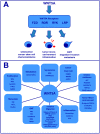Wnt5a Signaling in Cancer
- PMID: 27571105
- PMCID: PMC5040981
- DOI: 10.3390/cancers8090079
Wnt5a Signaling in Cancer
Abstract
Wnt5a is involved in activating several non-canonical WNT signaling pathways, through binding to different members of the Frizzled- and Ror-family receptors. Wnt5a signaling is critical for regulating normal developmental processes, including proliferation, differentiation, migration, adhesion and polarity. However, the aberrant activation or inhibition of Wnt5a signaling is emerging as an important event in cancer progression, exerting both oncogenic and tumor suppressive effects. Recent studies show the involvement of Wnt5a in regulating cancer cell invasion, metastasis, metabolism and inflammation. In this article, we review findings regarding the molecular mechanisms and roles of Wnt5a signaling in various cancer types, and highlight Wnt5a in ovarian cancer.
Keywords: Wnt5a; cancer; epithelial-mesenchymal transition (EMT); frizzled (Fzd); inflammation; microenvironment; non-canonical Wnt signaling; ovarian cancer; receptor tyrosine kinase-like orphan receptor (Ror); senescence.
Conflict of interest statement
The authors declare no conflict of interest.
Figures


References
-
- Torres M.A., Yang-Snyder J.A., Purcell S.M., DeMarais A.A., McGrew L.L., Moon R.T. Activities of the Wnt-1 class of secreted signaling factors are antagonized by the Wnt-5A class and by a dominant negative cadherin in early Xenopus development. J. Cell Biol. 1996;133:1123–1137. doi: 10.1083/jcb.133.5.1123. - DOI - PMC - PubMed
Publication types
Grants and funding
LinkOut - more resources
Full Text Sources
Other Literature Sources

